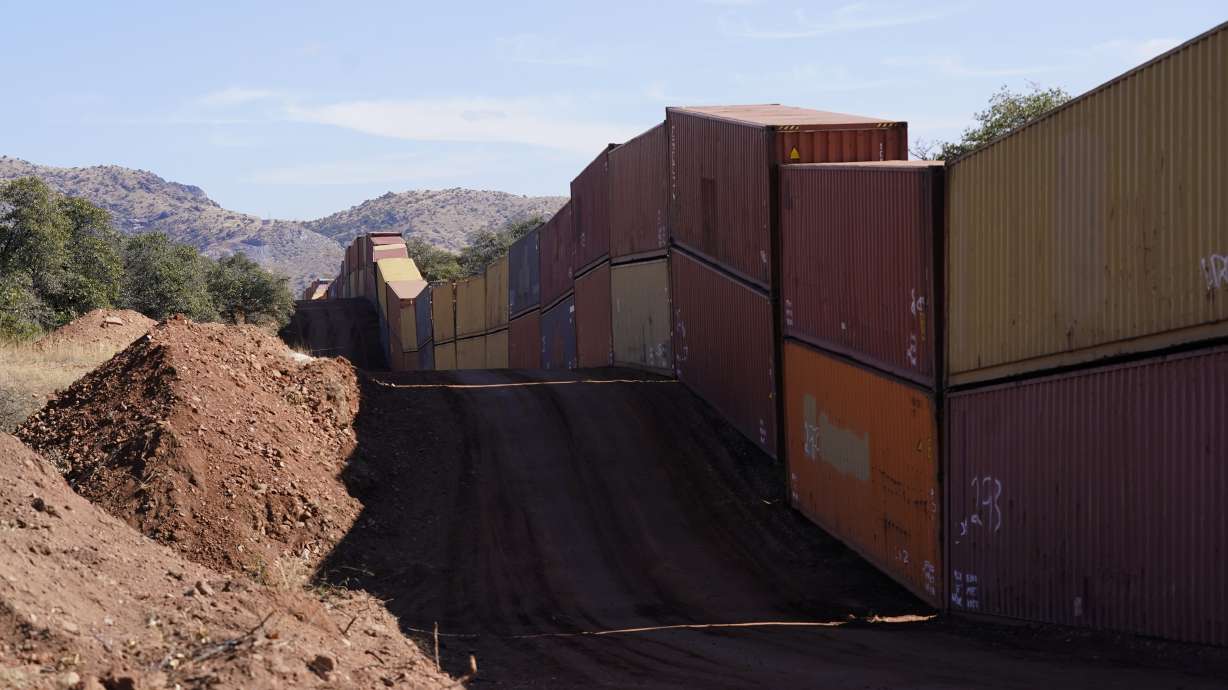Estimated read time: 4-5 minutes
This archived news story is available only for your personal, non-commercial use. Information in the story may be outdated or superseded by additional information. Reading or replaying the story in its archived form does not constitute a republication of the story.
SAN RAFAEL VALLEY, Ariz. — Work crews have steadily erected hundreds of double-stacked shipping containers topped by razor wire along Arizona's remote eastern boundary with Mexico in a bold show of border enforcement by Republican Gov. Doug Ducey even as he prepares to leave office.
Until protesters slowed, then largely halted the work in recent days, Ducey pressed forward over the objections of the U.S. government, environmentalists and an incoming governor who has called it a poor use of resources.
Democratic Gov.-elect Katie Hobbs said last week she was "looking at all the options" and hasn't decided what to do about the containers after her Jan. 5. inauguration. She previously suggested the containers be repurposed as affordable housing, an increasingly popular option for homeless and low-income people.
"I don't know how much it will cost to remove the containers and what the cost will be," Hobbs told Phoenix PBS TV station KAET in an interview Wednesday.
Federal agencies have told Arizona the construction on U.S. land is unlawful and ordered it to halt. Ducey responded Oct. 21 by suing federal officials over their objections, sending the dispute to court.
Environmental groups say the containers could imperil natural water systems and endanger species.
"A lot of damage could be done here between now and early January," said Russ McSpadden, a Southwest conservation advocate for the Center for Biological Diversity who has regularly traveled to the site since late October.
Ducey insists Arizona holds sole or shared jurisdiction over the 60-foot strip the containers rest on and has a constitutional right to protect residents from "imminent danger of criminal and humanitarian crises."
"Arizona is going to do the job that Joe Biden refuses to do — secure the border in any way we can." Ducey said when Arizona sued the U.S. government. "We're not backing down."
The federal agencies want Ducey's complaint dismissed.

Border security was a focus of Donald Trump's presidency and remains a potent issue for Republican politicians. Hobbs' GOP rival, Kari Lake, campaigned on a promise to dispatch the National Guard to the border on her first day in office. Texas Republican Gov. Greg Abbott, recently reelected to a third term, has pushed to keep building Trump's signature wall on the mostly private land along his state's border with Mexico and has crowdsourced funds to help pay for it. He also has gotten attention for busing migrants to Democratic-led cities far from the southern border, including New York City, Chicago, Philadelphia and Washington, D.C.
Ducey's move comes amid a record flow of migrants arriving at the border. U.S. border officials have stopped migrants 2.38 million times in the fiscal year that ended Sept. 30, up 37% from the year before. The annual total surpassed 2 million for the first time in August and is more than twice the highest level during Trump's presidency, in 2019.
Ducey's container wall effort began in late summer in Yuma in western Arizona, a popular crossing point, with scores of asylum-seekers arriving daily and often finding ways to circumvent the new barriers. The containers filled areas left open when Trump's 450-mile border wall was built. But remote San Rafael Valley — the latest construction site — is not typically used by migrants and was not contemplated in Trump's wall construction plan. McSpadden said he has not seen migrants or Border Patrol agents there, just hikers and backpacking cyclists.
The construction there stretches from oak forests in the Huachuca foothills southeast of Tucson and across the valley's grasslands. As of the middle of last week, cranes had transported more than 900 blue or rust-colored metal containers down a dirt road freshly scraped into the landscape, then double stacked them up to 17 feet high alongside waist-high vehicle barriers of crisscrossed steel. Workers bolted the containers together and welded sheet metal over gaps.
Still, yawning gaps remain in the new container wall, including an open space of several hundred yards on terrain far too steep to place the containers. In some low lying wash areas there are gaps nearly 3 feet wide.
Environmental activists demonstrating at the Cochise County site in the past week largely stopped the work in recent days by standing in front of construction vehicles. One recent day, a dozen demonstrators sat atop stacked containers or in camp chairs near tents and vehicles where they sleep.

The work in Yuma cost about $6 million and wrapped up in 11 days with 130 of the containers covering about 3,800 feet. The Bureau of Reclamation told Arizona it violated U.S. law by building on federal land. The Cocopah Indian Tribe also complained the state did not seek permission to build on its nearby reservation.
The newer project is far larger, costing some $95 million and using up to 3,000 containers to cover 10 miles, in Arizona's southeastern Cochise County. The U.S. Forest Service also told Arizona to halt its work in the Coronado National Forest, and recently alerted visitors to potential hazards posed by construction equipment involved in the state's "unauthorized activities."
The Center for Biological Diversity has sided with the federal government's position that the construction violates U.S. law.








